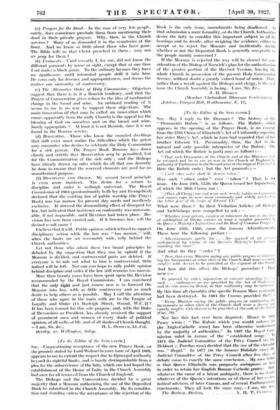[To the Editor of the SPECTATOR.] Sra,---May I reply to
Dr. Dear-1.11er ? The history of the " Ornaments Rubric " is as follows. The Rubric, which appears in the opening of the •Prayer Book, is an excerpt from the 25th Clause of Elizabeth's Act of Uniformity repealing her sister Mary's Act, which in turn had repealed that. of her brother Edward VI. Presumably, then, the Act is the natural and only possible interpreter of the Rubric. The Act (of which the Rubric is -part) runs as follows :—
" That such Ornaments of the Church and of the Ministers ,hall be retained and be in use as was in the Church of England hs authority of Parliament in the Second year of the reign of Edward Vt.
Here the Rubric ends ; but the Act proceeds :-
. Until other order shall N therein token."
Was such "other order" ever " taken" ? That is the issue. On June 24th, 1559, the Queen issued her Injunet lens, of which the 30th Clause rap:— " [That all Clergy] use and wear said' seemly 'whits atel •
and square caps as were most commonly and widely re.•,. the latter year of the .1vign of Edward lg."
What were those ? In their Visitation Articles all Bkh, and Archbishops were compelled to ask :---- " Whether your priests, curates or ministers do n.se in the I of celebration of Divine service to wear a surplice prescribed the Queen's Majesty's Injunctions and the Book of Common Pray r ••
On June 25th, 1560, came the famous Advertisement-. These bore the following preface :— " AdvertisOments partly for . . . au) apparel of all r • ecclesiastical by virtue of the Queen's Majesty's IA-tter- mending the same."
And what do they " order " ?
"Dem, that every Minister saying any public prayers or minist. • • ing the Sacraments or other rites of the Church shall wear a conwi:, surplice with sleeves to be provided at the expense of the Pati-■ And how did this affect the Bishops' procedure ? TIi were :— To proceed by order, injunction or censure according such . . . ordinances as are provided by the Act Of Parh • and the true meaning thereof, 80 that uniformity may be enfnr, Iy this time all chasubles (the specific Roman Mass vestment had been destroyed. In 1604 the Canons provided that "Every Minister saying the public prayers or ministering do Sacraments or other rites of the Church shall wear a deeent ac.■ comely surplice with sleeves to be provided at the cost of the !WW1 (Can. 58)."
Nor has this fact ever been disputed. Hence in Pusey wrote : "'flue Rubric which you would enforce PH the Anglo7Catholie sensel has been otherwise understood by the majority. of authorities." In 1867 the Royal Com' mission ruled in favour of the "established usage.- hi .1871 -the Judicial 'Committee of the Privy. Council On th' Hebbert v Purehas- ease) decided fhabthe use o? the chasubk -was ".illegal." In _1877 :(in the .famous *Hi/wale ease) the Judicial Committee -of. the Privy Council after five days 0! -debate came to exactly the same conclusion. _ My..own Wier .is that. Queen Elizabeth was. -purposely, ambiguous at firg -in order to. retain. her: English- Roman-Catholic gentry. HO' whatever the cause of a latent ambiguity, there is no doubt whatever of the Queen's intentions or of those of her eccles- iastical advisers, of later Canons, and of recent Parliament enactments.. They all look the same way.--I am, Sir, *e.'










































 Previous page
Previous page